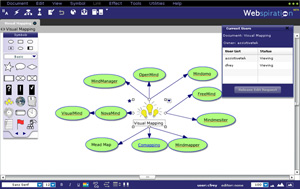 Inspiration Software , the developer of the well-respected and widely used mind mapping program Inspiration, has just released the beta of a web-based version of its flagship product. Dubbed Webspiration, it does an admirable job of translating the well-designed Inspiration user interface to the web, while adding collaboration capabilities.
Inspiration Software , the developer of the well-respected and widely used mind mapping program Inspiration, has just released the beta of a web-based version of its flagship product. Dubbed Webspiration, it does an admirable job of translating the well-designed Inspiration user interface to the web, while adding collaboration capabilities.
A webified Inspiration interface
A horizontal toolbar at the top of the screen contains map level tools, which can be used to add topics and hyperlinks, and to switch to outline view. Above that is a set of drop-down menus, containng document, edit, view, symbol, link, effects, utilities, tools and help.
The bottom of the screen includes formatting tools, which control such things as topic font, size and formatting, line and arrow styles and more. This part of the screen also contains map zoom and collaboration controls. Webspiration displays a list of the map users and editors; clicking on a name pops up a dialog box showing all of the current contributors to the map.
A familiar floating symbols toolbar, long a fixture on the Inspiration desktop, makes an appearance on the left side of the Webspiration desktop, too, providing quick access to topic shapes.
What can it do?
Like Inspiration, Webspiration can be used to create mind maps, concept maps and process flow charts. It also offers an outline view – which has long been one of my favorite capabilities of Inspiration.
Also, surprisingly, the program’s popular RapidFire brainstorming mode – which enables users to add topics and sub-topics to their maps using only the keyboard and the Enter key.
Overall, it’s a very rich, well-laid out workspace that closely mirrors the experience of mapping in Inspiration. I actually found myself forgetting that I’m creating a mind map within a web browser!
Collaboration enhances the mapping experience
The biggest new feature of Webspiration is collaboration – you can invite people to share and edit a map. Inspiration Software says this feature is ideal for team projects, study groups, and for co-authoring materials. The process is easy and quick; after you have sent your invites, a small, translucent dialog box pops up to let you know how many it sent – that’s nice user feedback.
One person can edit a map at a time; when you’re done editing it, you use the “current user” pop-up window to relinquish your editor role so the map owner can once again edit it. There is no integrated chat function at this time.
Integration with Inspiration
Webspiration can upload map files from Inspiration 8 to the web space, and vice versa. I tried downloading a map that Brian Friedlander and I worked on together in Webspiration (pictured above; click on image for a larger version). It saved the map as an .ISF file in the directory I specified, and it opened with no problems in Inspiration 8. I also uploaded a fairly complext Inspiration map to Webspiration, and it appeared there quickly, with no apparent problems. I was pleased to see that it placed this map in a separate tab from the one that I was co-editing with Brian. Nice!
Conclusion
Webspiration is an impressive web mapping tool. I’d hardly call it a beta version, however. It appears to be full featured, stable and behaves the way I would expect it to. In fact, the experience of using it is so similar to using Inspiration that I’d say that the developer has a real winner here. No pricing has been announced for Webspiration; I would guess that it will be available via a monthly subscription fee after it emerges from beta testing.

Leave a Reply